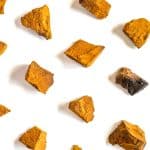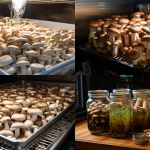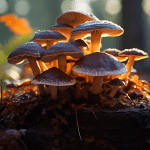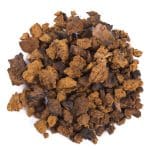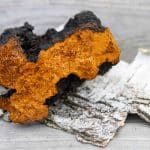This is the 2nd volume highlighting different types of mushrooms, and you can find the first volume here.
But we wanted to continue to highlight more of the amazing fungi that are available to you.
Wood Blewit Mushrooms
Wood blewits are considered edible, though some may have allergies to them. This is particularly true if eaten raw, though they may also trigger reactions if cooked. So, it is best to start with a low intake.
They can be found wild, but they are also grown in places such as Britain, France, and Holland. Blewits are eaten fried in butter or in cream sauce, stuffed into omelets, or cooked into stews.
Morel Mushrooms
Morel mushrooms are among the most sought-after wild mushrooms. They are not farmed or sold at stores. In fact, families often will have secret “morel patches” they know these mushrooms grow where they keep them to go and pick those tasty mushrooms every year.
Morel mushrooms taste like nuts, and are very earthy. They are a meaty texture, but they are still quite delicate. There are “true morels” and toxic “false morels,” so it is important to know the difference if you are going out hunting them. Read my complete morel mushroom guide to find out what morel mushrooms are, where they grow, and how to spot them.
Enoki Mushrooms
You will frequently find enoki mushrooms at your grocery store. These mushrooms are used more commonly in Asian cuisine. They are found in big groups of small mushrooms, which have a very long stalk with small caps. They are great in soups, particularly the Ramen.
Shimeji Mushrooms
Shimeji is another mushroom that is found throughout eastern Asia, however, can be found throughout northern Europe. They are also known as White Beech Mushrooms.
They give dishes rich umami flavours. However, they can be pretty bitter if eaten raw, so you always have to cook them. They are excellent in stir-fries, or topped on top of seafood or wild meats.
Shiitake Mushrooms
Shiitake mushrooms are often used in Asian cooking. They are also considered to have medical benefits in traditional Asian medicine. Shiitake mushrooms have a meaty texture, similar to Portobello mushrooms. They taste a bit smoky and earthy when cooked. Shiitake mushrooms are more often sold dried.
Maitake Mushrooms
Maitake mushrooms are also called woodhen mushrooms. However, these should not be confused with chicken-of-the-woods mushrooms. Nor with shiitake mushrooms, which have similar-sounding names as well. Maitake means “dancing mushrooms” in Japanese. These mushrooms are just too hard to eat when they grow up to any reasonable size.
However, they are used for their medicinal properties. Maitake mushrooms are shown to improve your immune system. They also have a hypoglycemic effect, which may help with lowering blood sugar levels and diabetes management, as well as helping with high cholesterol.
We are working on a (Maitake) Guide for an in-depth look at what Maitake Mushrooms are, how to identify them, and how to forage them or try growing your own. This recipe (adapted from The Forager Chef) is an easy, warming, and comforting way to enjoy maitake mushrooms. Toss mushrooms in butter, salt, garlic, and pepper. Spread out on baking sheets and roast 25-30 minutes, turning half way.
Reishi Mushrooms
Reishi, or Lingzhi, mushrooms are generally considered to be the gold standard when it comes to medicinal mushrooms. It is a polypore, meaning that it is a hard, cork-like mushroom, grown on tree sides, that is too hard to eat. It is pretty rare in the wild, but thankfully, now, on commercial scales, it is grown on hardwood logs or wood chips. Not all the effects of reishi mushrooms have been tested in the lab, but some purported uses include treating fatigue, lowering cholesterol, strengthening the immune system (sometimes claimed to even fight HIV and Aids), lowering blood pressure and inflammation, and treating symptoms of a low urinary tract.
Lion’s Mane Mushrooms
Lions manes grow in tufts on tree sides, in sloppy bundles, that may resemble something like a formation of stalagmites hanging within caves. Lions mane is supposed to improve focus and mood, maintain healthy brain function, support immune system, and reduce inflammation in the body. Unlike most medicinal mushrooms, lions mane is actually edible. It has a stringy, fleshy texture, with a sweet, salty taste compared to lobster or crab meat.
Matsutake Mushrooms
The Matsutake, or Pine Mushroom, is not well known in the west. But in Chinese, Korean, and Japanese cooking, it’s a mushroom that’s very highly prized. It has a distinct, pungent smell.
Matsutake mushrooms can be difficult to spot, as they grow beneath certain trees, usually hidden under leaves and other brush on the forest floor. They are also eaten rapidly by rabbits, deer, squirrels, and other wildlife, if they can find them first.
Giant Puffball Mushrooms
Puffer mushrooms have the potential to grow up to enormous sizes. Up to 20kg, or 44lb, in weight!.
However, they are harvested when still young and unripe, making them unsuitable for cooking. Once a puffed ball has turned yellow or brown, it has begun producing spores that may upset your stomach. Puffballs may be confused with immature versions of toxic mushrooms, which must be cut to check before eating.
Edible puffballs will have a white, solid inside, whereas other mushrooms will have yellowish insides or a cloak-like silhouette. If allowed to grow to their full size, puffball mushrooms will explode, sending out trillions of spores into the air.







